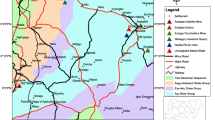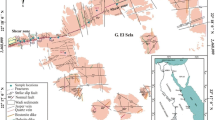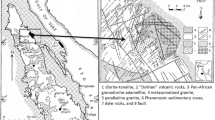Abstract
The determination of the natural radioactivity has been carried out, by means of gamma-ray spectrometry, in exposed rock samples collected from various geological formations across the Singhbhum Shear Zone of India. The spatial variation in the concentration of primordial radionuclides reflects, in general, the geochemical variance among the analyzed rocks and affirms the earlier views on genesis of uranium mineralization. This study further speculates new possibilities of thorium depletion during shearing and metamorphism. All the obtained U-values were more than the worldwide average U-concentration (which is about 40 Bq/kg). Interestingly, U-concentration in mica schists from Singhbhum group of rocks and in slates and argillaceous quartzites from Iron Ore group of rocks was five to seven times higher than the global values. In contrast, the granites in study area showed comparatively lower U-concentration. The overall results suggest the control of complex metamorphism and shearing on U-distribution in the terrane. The contribution of 238U, 232Th and 40K to the total radiation dose in the study area was found to be significant ranging from 110 to 310 nGy/h in comparison with the lower global, as well as Indian average values.




Similar content being viewed by others
References
Adams JAS, Osmond JK, Rogers JJW (1959) The geochemistry of thorium and uranium. Phys Chem Earth 3:298–348
Ahmed NK (2005) Measurement of natural radioactivity in building materials in Qena city, Upper Egypt. J Environ Radioact 83:91–99
Banerjee KS, Sengupta D (2010) Distribution pattern of the in situ terrestrial gamma radiation in uranium mineralised Singhbhum Shear Zone, Jharkhand, India and its correlation with local geology. Curr Sci 98(1):76–81
Bhattacharya DS (1992) Early Proterozoic metallogeny, tectonics and geochronology of the Singhbhum Cu-U belt, eastern India. Precambr Res 5r:71–78
Churchill R (2006) Geologic controls on the distribution of radon in California, radon potential in Ventura County 2006 Update. Spl. Report 1994. California Geological Survey
Florou H, Kritidis P (1992) Gamma radiation measurements and dose rate in the coastal areas of a volcanic Island, Aegean Sea, Greece. Radiat Prot Dosimetry 45(1):277–279
Fokianos K, Sarrou I, Pashalidis I (2007) Increased radiation exposure by granite used as natural tiling rock in Cypriot houses. Radiat Meas 42(3):446–448
Ghosh SK, Sengupta S (1987) Progressive development of structures in a ductile shear zone. J Struct Geol 9:277–287
Gundersen LCS, Wanty RB (eds) (1971) Field studies of radon in rocks, soils, and water. U.S. Geological Survey Bulletin, pp 39–50
Johnson SS (1979) Radioactivity surveys: Virginia Division of Mineral Resources. Virginia Miner 25(2):9–15
Kamath RR, Menon MR, Shukla VK, Sadasivan S, Nambi KSV (1996) Natural and fallout radioactivity measurement of Indian soils by gamma spectrometric technique. In: Proceedings of the Fifth National Symposium on Environment, pp 56–60
Kathren RL (1998) NORM sources and their origins. Appl Radiat Isot 49:149–168
Krishan S, Vishwanathan G, Balachandran K (2001) Heavy minerals sand deposits of Kerala. Special issue on beach and inland heavy minerals sand deposits of India. Explor Res Atomic Miner 13:111–146
Lide DR (ed) (1994) CRC handbook of chemistry and physics, 75th edn. CRC Press, Boca Raton
Misra S (2006) Precambrian chronostratigraphic growth of Singhbhum–Orissa raton, Eastern Indian Shield: an alternative model. J Geol Soc India 67:356–378
Mohanty AK, Sengupta D, Das SK, Saha SK, Van KV (2004) Natural radioactivity and radiation exposure in the high background area at Chhatrapur beach Placer deposit of Orissa, India. J Environ Radioact 75:15–33
Mukhopadhyay D, Deb GK (1995) Structural and textural development in Singhjbhum Shear Zone, eastern India. Proc Indian Acad Sci (Earth Planet Sci) 104(3):385–405
Mustapha AO, Narayana DGS, Patel JP, Otwoma D (1997) Natural radioactivity in some building materials in Kenya and the contributions to the indoor external doses. Radiat Prot Dosimetry 71:65–69
NCRP (1975) Background radiation in the USA recommendation of the National Council of Radiation and Measurements. Report no. 45
Obed RI, Farai IP, Jibiri NN (2005) Population dose distribution due to soil radioactivity concentration levels in 18 cities across Nigeria. J Radiol Prot 25:305–312
Passchier CW, Trouw RAJ (2005) Microtectonics, 2nd edn. Springer, Berlin, pp 118–158
Pavlidou S, Koroneos A, Papastefanou C, Christofides G, Stoulos S, Vavelides M (2006) Natural radioactivity of granites used as building materials. J Environ Radioact 89:48–60
Radiation Protection 112 (1999) Radiological protection principles concerning the natural radioactivity of building materials. European Commission Report, Brussels
Roger JJW, Adams JAS (1969) Uranium. In: Wedephol KH (ed) Handbook of Geochemistry. Springer, Berlin (Section 92 B–O)
Saha AK (1994) Crustal evolution of Singhbhum North Orissa, Eastern India. Geological Society of India, Memoir 27:281–307
Sarkar SC (1982) Uranium (–nickel–cobalt–molybdenum) mineralization along the Singhbhum Copper belt, India and problem of ore genesis. Miner Deposita 17:257–278
Sarkar SC (2000) Crustal evolution and metallogeny in the eastern Indian craton. Geological Survey of India Special Publication 55:169–194
Sengupta D, Kumar R, Singh AK, Rajendra P (2001) Radon exhalation and radiometric prospecting on rocks associated with the uranium mineralisation in the Singhbhum shear zone, Jharkhand. Appl Radiat Isot 55:889–894
Shaikh AN, Ramachandran TV, Eappen KP, Mayya YS, Khan AH, Puranik VD, Hoda SQ (2004) A case study of radon–thoron concentrations in dwellings around uranium deposit sites in Meghalaya. In: Proceedings of the Thirteenth National Symposium on Environment, Shillong, India:437–440
Smith DK Jr (1984) Uranium mineralogy. In: De Vivo B, Ippolito F, Capaldi G, Simpson PR (eds) Uranium geochemistry, mineralogy, geology, exploration and resources. The Institution of Mining and Metallurgy, London, pp 43–88
Sunta CM (1993) A review of the studies of high background radiation areas of SW coast of India. In: Proceedings of the International Conference on High Levels of Natural Radiation Areas, Iran, 1990. IAEA Publication Series. IAEA, Vienna:71–86
Trevisi R, Bruno M, Orlando C, Ocone R, Paolelli C, Amici M, Altieri A, Antonelli B (2005) Radiometric characterisation of more representative natural building materials in the province of Rome. Radiat Prot Dosimetry 113(2):168–172
Tzortzis M, Tsertos H, Christofider S, Christodoulides G (2003) Gamma-ray measurements of naturally occurring radioactive samples from Cyprus characteristic geological rocks. Radiat Meas 37:221–229
UNSCEAR (2000) Sources and effects of ionizing radiation. United Nations Scientific Committee on the Effects of Atomic Radiation Report to the General Assembly, with scientific annexes, I
Verdoya M, Chiozzi P, Pasquale V (2001) Heat-producing radionuclides in metamorphic rocks of the Brianconnais–Piedmont Zone (Maritime Alps). Eclogae Geol Helv 94:1–7
Virnave SN (1999) Nuclear Geology and Atomic Mineral Resources. Bharati Bhawan Publishers and Distributors, India
Acknowledgments
The present study is a part of the Ph.D. work undertaken at IIT Kharagpur and the first author (K.S. Banerjee) is thankful to All India Council for Technical Education (AICTE), New Delhi, India and Board of Research in Nuclear Sciences, Department of Atomic Energy, Bhabha Atomic Research Centre (BARC), Mumbai, India, for sponsoring him with a research fellowship. We are thankful to Dr. Y.S. Mayya and Mr. B.K. Sahoo for their kind suggestions in this work. We are thankful to the Uranium Corporation of India Ltd., Jaduguda, Jharkhand, India and Dr. S. Misra for their help during the field surveys.
Author information
Authors and Affiliations
Corresponding author
Rights and permissions
About this article
Cite this article
Banerjee, K.S., Guin, R., Gutierrez-Villanueva, J.L. et al. Variation in U-238 and Th-232 enrichment in U-mineralized zone and geological controls on their spatial distribution, Singhbhum Shear Zone of India. Environ Earth Sci 65, 2103–2110 (2012). https://doi.org/10.1007/s12665-011-1191-9
Received:
Accepted:
Published:
Issue Date:
DOI: https://doi.org/10.1007/s12665-011-1191-9




